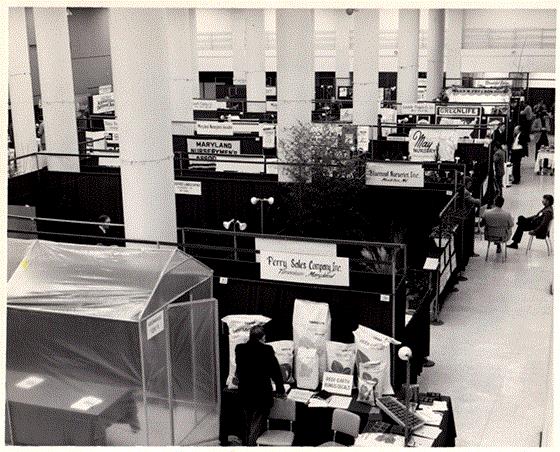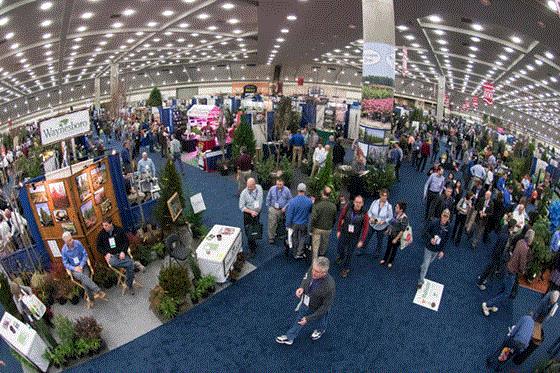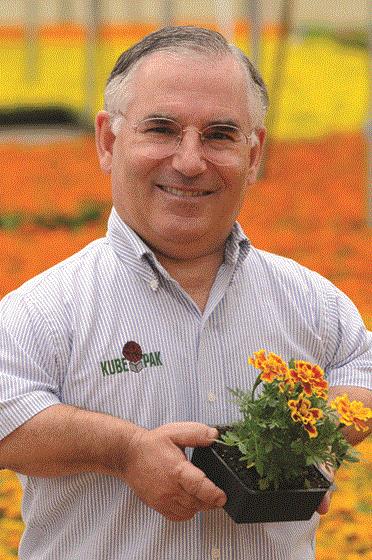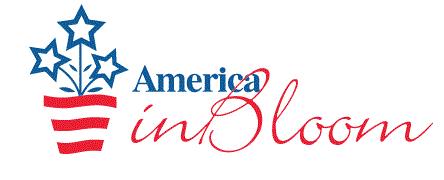MANTS at 50
There’s one big industry trade show that I have not yet attended, and that’s MANTS–the Mid-Atlantic Nursery Trade Show, held in Baltimore every January. But our Jen Zurko has been numerous times, and she went again this year to see the 50th installment of the big event. Here’s her report on the history of the birthday:
As a fourth-generation nurseryman, Carville Akehurst and several of his fellow nursery growers were looking for another, more local, way to expand their sales reach and network within the Mid-Atlantic’s horticulture industry. So in 1969, he and other members of the Maryland and Virginia state landscape associations put their heads together and came up with the Mid-Atlantic Nursery Trade Show—better known as MANTS.
Last week, MANTS celebrated 50 years of being the first horticulture trade show on our industry’s annual calendar.
As one of the original founders of the show, Carville was MANTS’s first executive vice president, and he started his own management company that handled organizing MANTS every year.
After his passing in 2001, Carville’s wife, Nancy, inherited the management company, but she didn’t want to run it full-time. So she asked one of her daughters, Vanessa Finney, if she could help. Vanessa was home with a newborn baby and had plans to take a year off from her regular CPA job to stay home and be a mom to her three young children, but she agreed.
 Carville on his tractor.
Carville on his tractor.
Nancy and Vanessa originally didn’t intend to keep MANTS, but the 2002 show went off smoothly and they realized how well everything worked, so Quercus retained management of the show.
“It wasn’t easy; it was very hard,” Vanessa admitted. “We had to gain the board’s trust and it took a few years for that trust to be earned. That we had the chops to manage it.”
When MANTS started, they had 64 exhibitors and about 150 attendees; 50 years later, they have over 950 exhibitors and see 12,000 people in the aisles. Vanessa said they’ve grown little by little through the years, expanding into the 300,000 sq. ft. of convention center space, hitting capacity in the current footprint in 2004 and continue with a waiting list of about 120 companies.

MANTS in 1974 (above) and today (below).

It’s interesting how much MANTS has grown. It started off exclusively with a nursery focus, but now you see a more diverse offering of products, with perennials, grasses, hardgoods, and even a smattering of annuals.
“The difference is we started as a nursery show—a lot of green,” said Vanessa. “We still have a lot of trees and shrubs and plant material, but we have evolved to everything that’s soup to nuts—that’s anything to do with horticulture production or end sale.”
Other changes the show has seen over the years is less “ball and burlap” (more of a focus on container production and other product forms), more automation (which a lot of shows are seeing) and changing demographics (the “men’s” was taken off “nursery” in the name in 1996). The show has also expanded to offer more sponsorship opportunities for exhibitors, which Vanessa’s husband, Kelly, started when he came on board in 2004. More areas around the convention center are available for exhibitors to promote their products and businesses.
“MANTS was always bare bones; we didn’t do anything super fancy,” said Vanessa. “We have a little bit more of that now than we used to, and it adds interest and a little more excitement to the show.”

Westerlay adding 4 acres
Proving that business is strong—at least for this grower—Westerlay Orchids of Carpinteria, California, has leased 4 acres of additional greenhouse space in Carpenteria, which they say will allow them “to increase production and explore exciting new varieties just in time for Mother’s Day.” It also helps them initiate a planned expansion in national distribution from 3 million to 4 million plants by 2021—a 33% increase!
Third-generation owner Toine Overgaag told me via email that the site they’re taking over had been a producer of tomatoes and cucumbers for some 20 years. Canadian nursery Fernlea then leased the space for perennials, but they’re moving to a larger space, giving Westerlay a crack at the facility. In it, they’ll grow about 900,000 2-in. “Darling” phalaenopsis year-round, and 250,000 3-in. and 5-in. phalaenopsis production for Mother’s Day. “There is still 1 acre of space that we will be devoting to a new, still-to-be-determined product,” he added.

Toine in Westerlay’s new digs.
As for upgrades to the old facility, Westerlay will be replacing and adding climate screens, an irrigation system, high-pressure misting and mobile tables for internal transportation.
In other words, some equipment companies are going to be doing more business this spring, too!

Campaign introduces youth to the benefits of plants
A new contest from Seed Your Future will challenge students to explore how plants can solve issues in their community. The contest is called “Plants to the Rescue!” and it’s designed to excite young people about the power of plants and their unique ability to help solve some of the most pressing problems in our communities. It’s part of Seed Your Future’s “Bloom” campaign, which is intended to promote horticulture to middle-schoolers and inspire in them an interest in horticultural careers.

(A quick reminder: Seed Your Future is a coalition of more than 200 partners, including horticulture companies, gardening organizations, schools, colleges, universities, public gardens, youth organizations, nonprofit organizations and individual advocates, all united by the mission to promote horticulture and careers working with plants.)
“Youth have told us that they want to help solve some of the most difficult problems in our world today,” said Susan E. Yoder, executive director of Seed Your Future. “They hear about world-hunger, climate change, flooding, air pollution, noise pollution, food deserts and more and they’re anxious to do something about it—but they don’t know how or even what would make a difference. BLOOM! helps them to identify the root of each challenge and opens their eyes to how plants and the people who work with them can make a positive difference.”
The new the “Plants to the Rescue! Plant Mash-up” contest and sweepstakes challenges students to imagine their own plant hybrid with unique qualities to benefit a specific need in their own community. They will select an issue, then describe a new plant-based solution and illustrate their idea. Prizes will be awarded to both the student and the educator/youth program leader/parent of the winning submissions. In addition, a sweepstakes component of the contest gives every submission the chance to be a winner.
In addition, Seed Your Future has expanded its educator website, Scholastic.com/BLOOM. The site includes sample lesson plans, student activities and a robust online learning module. The module contains a dynamic video along with a trivia game, virtual plant dissection tool and plant-matching game to reinforce the learning in the activities and video.
Seed Your Future’s premise is that whether BLOOM! introduces today’s youth to a lifelong passion or a fulfilling career, one thing is clear: the more you know about plants, the more you can make a difference in the world today.

Beacon Impatiens to get GRAMMY red carpet treatment
The official botanical artist of the GRAMMY Awards, Tu Bloom (yes, that’s the fellow’s name), will be putting PanAmerican Seed’s new Beacon impatiens front and center during “Music’s Biggest Night” when he and his company, Tu Bloom Designs, builds 40 topiaries of Beacon White atop a carpet of Beacon Bright Red. In total, 3,700 plants will decorate the entrance to The Staples Center in Los Angeles during the event. They’re being grown by Kawahara Nurseries of Morgan Hill, California.
What you want to know is how in the world do you get your plant variety into the GRAMMYs, right? I asked Ball’s PR expert Katie Rotella about that:
“We supplied Burpee and Cool Wave plants to the Philadelphia Flower Show last year for the ‘Potting Parties’ hosted by Tu Bloom Design on their showcase stage. Tim Duffin, Alyson Upshaw and I traveled to see the show and how engaged the audience was with the plants and with Tu. He was wonderful! He had great enthusiasm and an easy way to empower the full audience of gardeners [who were] getting the chance to pot up and take home their own personally designed mixed container.
“In between his evening segments, Tu toured with us around the show and we got to talking. He mentioned he was looking for a garden-inspired GRAMMYs design, so we continued our talks well past the event. Several months later (and after he visited The Gardens at Ball for our consumer media day) he had a fantastic idea for White Beacon topiaries rising above a bed of Bright Red Beacon ... a mirror of the red carpet, and very elegant, yet totally achievable by gardeners at home.
“Tu knows the power of plants and good design. It’s a great match for his skilled eye and the spring debut of our new top-performing impatiens series."

Tu Bloom, looking sharp in a jacket and tie that celebrate what we all love—flowers!
Tune in Sunday, January 26, to the GRAMMY pre-shows (where they show the stars on the red carpet) to check them out. You can impress your music-loving friends with your plant ID skills!

AAA on gasoline prices
Remember when $4-plus-a-gallon gasoline was common and we all were giving our pickup trucks and SUVs dirty looks as the numbers on the pump flipped past the $100 mark?
But today, despite crude oil price fluctuations and the ratcheting up of tensions in the Middle East, the national gas price average has held steady at $2.58 since January 1. That’s not bad … although it’s 2 cents higher than December and 34 cents more than January 1, 2019.

AAA explained it thusly in a recent press release: “A healthy and growing level of domestic gasoline stocks alongside decreasing demand are two factors helping to minimize gas price fluctuations.”
Bill Swanekamp on heating fuel prices
Because of the above, I got curious about greenhouse heating costs—namely natural gas, which is what the majority of you burn when you have to burn something. Back when natural gas was hitting $10 a dekatherm, I was reporting on Henry Hub prices nearly ever week during the winter. Now, I can’t recall when the last time I thought about greenhouse heating costs. So I emailed my fuel guru, Bill Swanekamp of Kube-Pak Greenhouses in New Jersey, to get his take on the situation:

The Energy Matrix is very interesting right now. The cost of natural gas (NG) is extremely low, almost to the point of no profit for the gas companies. The only ones making money right now are the companies that transport the NG, and I think they are connected to the drilling companies, as well.
Although there are some environmental issues with fracking, it is the single driving force behind the low cost of NG. So much production has been found all over the US that the cost of the NG has dropped to unheard-of low levels. This, of course, is good for our industry, as long as you can burn NG, but for the other fuels that are out there, like oil or propane, they have maintained a relatively moderate to high price.
As an example, we can have NG delivered to our greenhouse for about $5 per dekatherm, while #2 heating oil is about $21 per dekatherm—more than four times the cost of NG. This is an enormous swing in price and cost to burn.
This also bodes poorly for wood burning. Right now, you can burn NG for about the same cost as wood (if you include the cost of building a large wood-burning facility).
There is so much NG available to burn that the utilities are switching to NG away from coal, hence the loud uproar from the miners in West Virginia. But the cause of this switch is not political, it’s simply supply verses demand. So many permits were issued by the government to frack for NG that coal cannot compete with the price or cleanliness of the burn of NG.
The real question is this: How long will this present situation last? Remember, it was only 12 years ago that the cost of NG was $18 per dekatherm. Then fracking began in earnest, and look what has happened. Right now, the major NG producers are working hard at converting NG to LNG (liquified natural gas) to transport it to other countries. Once this ramps up to large volumes, watch what happens to the cost of NG: up, up and away!
Bill closed with this word of advice to all greenhouse owners:
If you are not burning NG right now, it is time to speak with your local utility to see if they will bring NG to your greenhouse.
This makes me wonder: For those of you who've invested in biomass boilers, what's the wood vs. NG situation like for your business? Weigh in HERE.
For more of Bill's wisdom, check out these PAST COLUMNS from GrowerTalks.

Action alert for Jan. 16: Help save H-2B!
The 2020 Consolidated Appropriations bill that Congress passed in December included language that allows the Secretary of Homeland Security to release additional H-2B visas to meet American business needs.
Relief is urgently needed: 99,362 applications for H-2B visas for jobs beginning April 1 or later have already been filed, yet only 33,000 visas are available. This is a looming spring workforce crisis and will hurt the entire horticulture industry.
Reps. Andy Harris and Chellie Pingree have authored a letter encouraging the DHS secretary to release additional visas to meet this demand. The deadline for member action is January 16.
Help us ensure that businesses needing H-2B workers after April 1 have access to this program by encouraging your member of Congress to sign the Harris/Pingree letter asking the secretary to take action NOW.
Let your elected officials know you support the H-2B program and the Harris/Pingree letter. HERE is a link to an easy-to-use digital letter.
Get your town into America in Bloom!

It's time to register your community to participate in the 2020 America in Bloom National Awards Program. The deadline to register is February 28. Bonus: if you recruit another AIB participant, you can save up to 25% on your registration costs.
To learn more about the program, the benefits of participation and how to make the most of your experience, click HERE.
Finally I ...
Congratulations to Metrolina Greenhouse's Thomas and Lindsey VanWingerden, proud parents of little Ellie Michelle, born January 10 (about 10 days earlier than expected, Thomas told me). Ellie is their second (Thomas Jr. is 2 1/2).

Now, I generally avoid putting babies in Acres Online. But hey, this is a new VanWingerden, and that means a future greenhouse owner!
Or perhaps a future race car driver—Ellie’s maternal grandfather is famed NASCAR driver Mike Wallace, and her great uncles are none other than Rusty and Kenny Wallace.
If nothing else, she’ll deliver plants real fast!
Finally II …
The holidays are over and spring is around the corner, which means I’ve got to get off my lazy you-know-what and hit the road! Which is why you’ll next be reading about TPIE—The Tropical Plant International Exposition—from Ft. Lauderdale, Florida, and IPM Essen from Essen, Germany.
These two events are favorites of mine because they both deliver boatloads of new products and trendy ideas for the grower and retailer. TPIE has its emphasis on tropicals and houseplants—and we all know how hot those categories continue to be—while IPM offers some of that plus annuals, perennials, potted plants, woodies, greenhouses technology and sexy marketing ideas from Europe’s most inventive horticulture companies.
By the way, just as I was about to hit the “launch” button on this email, I heard from FNGLA’s Linda Adams that TPIE buyer preregistrations are up 24% from this time in 2019. And a good number of those folks are TPIE first-timers—a sign that the houseplant craze may be bringing retailers out shopping.
Fellow TPIE committee member Erik Dietl-Friedli of Flamingo Road Nursery in Davie, Florida, agrees that houseplants remain hot, especially with younger consumers. He told me via email, “When I walk our houseplant area, the average age of our customer in there is almost half that of other areas. And they are very educated on what they are looking at and for. They know what they want, and they shop often.”
Which is why YOU should be at TPIE. It’s January 22-24. It’s Ft. Lauderdale. It’s warm. It’s trendy. What other excuses do you need to escape the greenhouse?





See you next time,

Chris Beytes
Editor
GrowerTalks and Green Profit
This e-mail received by 21,414 loyal readers!
Thanks to my loyal sponsors, who help me reach the 21,414 readers of Acres Online in 66 countries. Want to be one of them (a sponsor, that is)? Give Paul Black a shout and he'll hook you up.